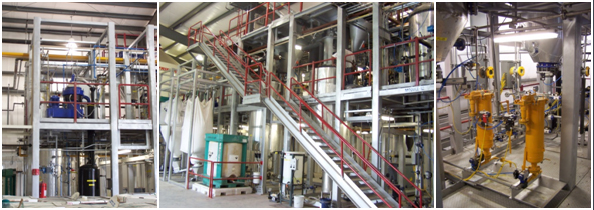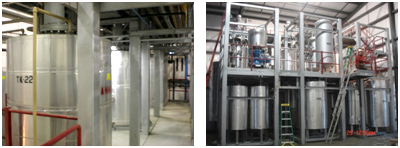|
Biodiesel Plants
Biodiesel Plants for Used Cooking-Oil, Corn-Oil, Jatropha-Oil, Camelina Oil, Fatty-Acids, and other Animal Fats and Vegetable Oils The most common form of Biodiesel is a “Methyl Ester” of Fatty Acids. It is commonly called “Fatty Acid Methyl Ester” (or FAME).
Why Biodiesel?
Refined Vegetable Oils and Animal Fats have almost the same energy value as biodiesel; hence they can be used as fuel in Diesel Engines. However, there are two major problems with using Oils and Fats as Fuel. First, the Oils & Fats are highly viscous. Moreover, the viscosity increases dramatically at lower temperatures causing flow issues. Second, the Oils & Fats have a higher melting point. This implies that they can solidify at lower temperatures causing flow issues. Converting Oils & Fats into FAME (Biodiesel) lowers the viscosity as well as melting point. There are still limits to the extent to which the melting point can be reduced but Biodiesel has more utility than Oils & Fats as a source of fuel.
What is Biodiesel Produced from?
Biodiesel can be produced either from Fatty Acids or Oils. Oils are commonly called Tri-Glycerides or “Fatty-Acid Gylcerin Esters” (FAGE).
What is Esterification?
Esterification involves a reaction of an Alcohol (such as Methanol) with Fatty Acids. The reaction produces Fatty Acid Methyl Esters. One molecule of Fatty Acid reacts with one molecule of Methanol to produce one molecule of FAME. The by-product of this reaction is one molecule of Water. The Esterification process requires an “Acid” Catalyst to facilitate the reaction.
What is Trans-Esterification?
Trans-Esterification involves a reaction of an Alcohol (such as Methanol) with Oil. Because both Oil and Biodiesel belong to Ester family, the conversion of one type of Ester (FAGE) to another type of Ester (FAME) is called Trans-Esterification. One molecule of Oil (FAGE) reacts with three molecule of Methanol to produce three molecules of FAME. The by-product of this reaction is one molecule of Glycerin. The Trans-Esterification process requires a “Base” Catalyst to facilitate the reaction.
Pre-Treatment:
Pre-Treatment is the process of eliminating impurities from Oils and Fats so that the FAME produced from such Oils and Fats is also free of such impurities. All feedstock (i.e., Animal Fats and Vegetable Oils) have impurities such as water, solids, gums, free-fatty acids (FFA), waxes, and compounds of Sodium, Potassium, Magnesium, Calcium, and other metals.
Pre-Treatment process can be custom designed to be feedstock-dependent or feedstock-independent. Feedstock-dependent means the plant is custom-designed for a specific type of feedstock. For example, it could be designed for processing Extracted Corn Oil (XCO). Feedstock independence comes at a higher capital cost but allows the plant to be multi-feedstock ready. Such a plant can process different types of feedstock even though some feedstock may not require each processing step in the plant.
Pre-Treatment Options:
The goal of Pre-Treatment is to reduce the impurities such as water, solids, gums, FFA, and metallic compounds. The Trans-Esterification-ready feedstock should typically meet the following specifications:
Solids <0.1% The following four Pre-Treatment processes (or combination thereof) are possible depending upon the nature of the impurities in the feedstock:
Refining is suitable for virgin vegetable oils such as Canola, Camelina, Cottonseed, Rapeseed, Soybean Oil or Animal Fats, which have low FFA (less than 3%).
FFA stripping is suitable for virgin oils such as Coconut, Jatropha, Palm Oil, Used Cooking Oil, or Animal Fats, which have high FFA (above 3%). If in place, this process is preferred even for lower FFA oils.
Esterification is suitable for oils which have moderately high or very high FFA (usually above 2%).
Glycerolyis is suitable for oils which have very high FFA (usually above 20%) Degumming and dewaxing may be required in addition to the above-mentioned steps if the Oils have higher levels of gums and waxes. There are advantages and disadvantages of each type of process. The biggest disadvantage of Esterification is that it requires the use of “Sulfuric Acid” as a catalyst. This poses challenges with respect to operator hazard and equipment failure due to corrosion. Although such challenges can be overcome with the use of heterogenous (solid) catalyst; however, solid catalysts pose other challenges that may require additional investment in Pre-Treatment equipment. Another disadvantage of Esterification is that the amount of Methanol required during Esterification is very high; thus requiring additional investment in methanol recovery and rectification equipment. The main disadvantage of FFA stripping is that it removes the FFA from the Oil resulting in yield loss. Although such loss is not a complete loss of yield because FFA can be sold to partially recover the value of the feedstock. A challenge of FFA stripping is that it works under very high temperature and vacuum; thus requiring additional investment in heating and vacuum equipment.
Trans-Esterification
Trans-Esterification involves the conversion of Oils (FAGE) to Biodiesel (FAME). The most commonly used process involves a continuous two-stage reaction with Methanol in the presence of a “Base” catalyst (typically Sodium Methoxide).
Each reaction stage is followed by separation of Biodiesel and Glycerin. Unfortunately, the trans-esterification process produces soaps (salts of fatty-acids) that remain in Biodiesel and Glycerin phases. It is important to note that the amount of soap produced is directly proportionate to the amount of FFA in the Oil. In order to reduce the production of soap, it is critical to remove FFA from the Oils during the Pre-Treatment step. Another impurity in both phases is un-used Methanol. Consequently, the biodiesel phase must be “washed” to remove soaps and methanol. An important point to note is that Sodium Methoxide is a homogenous (liquid) catalyst and has a tendency to produce soaps. However, use of heterogenous (solid) catalysts results in much smaller production of soaps. As a result, the washing of the biodiesel is easier.
Biodiesel Wash
There are two ways to wash biodiesel:
Post-Treatment
Washed and dried biodiesel is practically a finished product. However, there are certain impurities that may prevent passing ASTM specs. Post-treatment has traditionally involved a “Silica” treatment to remove traces of soaps and metallic impurities. In addition, for some feedstocks, a “Winterization” process is required to remove waxes, higher melting-point glycerides, sterols, and/or derivatives of sterols. These steps may be avoided if the biodiesel is subjected to distillation as explained below.
Biodiesel Basics:
|
||||
|
||||








